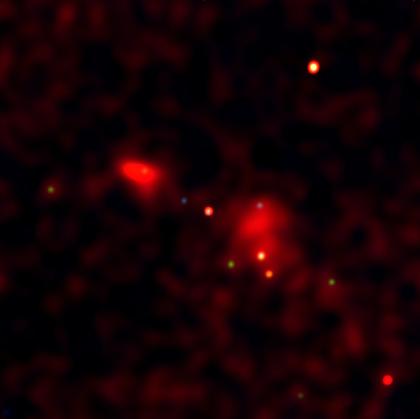Merging Galaxies And Cosmic Collisions
The Chandra image of Arp 270 shows two galaxies about 90 million light years from Earth in the early stage of a merger. The future evolution of these galaxies will be radically changed by the merger as their mutual gravity distorts their shape, and the collision of gas clouds in the galaxies stimulates the formation of new stars.
The hot spots (blue) located where the disks of the galaxies are colliding are thought to be due to the formation of hundreds of thousands of new stars as the two gaseous disks rotate through each other.
These bursts of star formation create many massive stars that generate intense winds of hot gas, and these stars eventually explode as supernovas. This violent activity produces the hot gas clouds that surround the galaxy disks (red).
Astronomers hope to understand more about how supermassive black holes are formed in the centers of galaxies by studying galaxies at different stages in the merging process. These studies will also provide valuable insight as to how our own Milky Way Galaxy formed and evolved.
In the image, red represents low, green intermediate, and blue high-energy (temperature) X-rays.
|
||||||||||||||||||||||||||
A Chandra X-ray Observatory image of Arp 270 shows two galaxies about 90 million light years from Earth in the early stage of a merger. The bow-tie like object is mostly bright red on a black background with several small dots of light scattered across it. The future evolution of the two galaxies will be radically changed by the merger as their mutual gravity distorts their shape, and the collision of gas clouds in the galaxies stimulates the formation of new stars. The hot spots (blue or green dots) located where the disks of the galaxies are colliding are thought to be due to the formation of hundreds of thousands of new stars as the two gaseous disks rotate through each other. These bursts of star formation create many massive stars that generate intense winds of hot gas, and these stars eventually explode as supernovas. This violent activity produces the hot gas clouds that surround the galaxy disks (in red). In the image, red represents low, green intermediate, and blue high-energy X-rays respectively.





